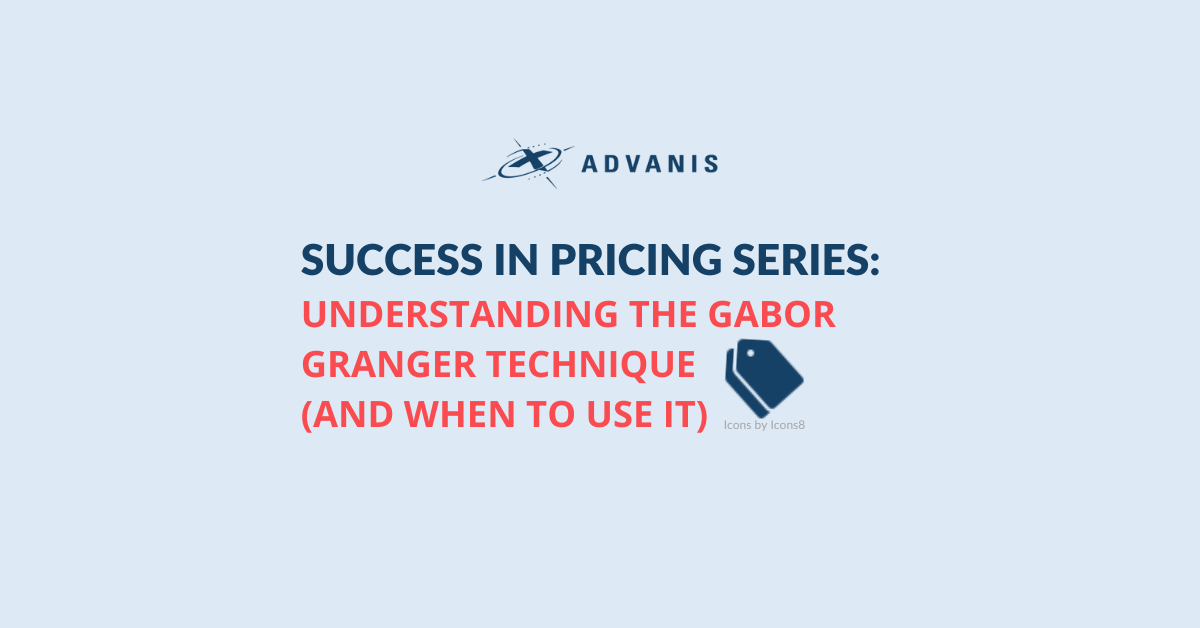
Success in Pricing Series Part Two: Understanding the Gabor Granger Technique (And When to Use It)
Which price is right for your new product or service? There are three common pricing research methods to help you find out: Van Westendorp, Gabor Granger, and Choice-based Conjoint Analysis. Each has its own strengths, and which to choose depends largely on the stage of product development, the complexity of the product, and the specific pricing questions you need to answer. Clear as mud, right? Fortunately, we’ve used these techniques to provide impactful and actionable answers to pricing questions for over 100 brands and organizations locally and globally. We have created this three-part series, Success in Pricing, to help you better understand each technique. For part two, we’re discussing the Gabor Granger technique.
Gabor Granger Technique
Best used for determining the optimal price point, the Gabor Granger technique involves showing respondents a series of price points and asking them how likely they are to purchase the product or service at each price. The goal is to determine the maximum price at which a majority of consumers are willing to buy.
When It Is Used:
- For Established Products: If your product or service is already on the market and you want to optimize the price, Gabor Granger can help pinpoint the price that maximizes revenue or market share.
- Testing Specific Price Points: When you have a few price points in mind and want to test them directly with consumers, this method allows you to see how price changes might affect demand.
- To Estimate Demand at Different Prices: Gabor Granger is useful for estimating demand curves and understanding how changes in price affect the likelihood of purchase.
Limitations:
- Simplification of Consumer Behavior: The Gabor Granger technique often assumes that the relationship between price and demand is linear or smoothly declining. However, in reality, consumer behavior may exhibit non-linear patterns, such as price thresholds, where small changes in price lead to significant changes in demand.
- Limited Feature Impact Analysis: While Gabor Granger is effective for single products or services, it doesn’t account for variations in product features or configurations, which might impact consumer preferences.
- Potential for Bias in Respondent Answers: The sequence in which prices are presented can influence responses. For example, starting with a high price might anchor respondents to expect higher prices, while starting with a low price might anchor them to expect lower prices, skewing the results.
Brand, Pricing and Messaging Example:
- A leading med-tech company needed to understand how to best market and sell the benefits of their brand in an emerging space and at what price level.
- We conducted an online survey among surgeons and hospital administrators in the United States to determine willingness to pay price ranges, price sensitivity to our client’s brand v. the competition, and interest in technology to understand brand strength to influence purchase decisions.
- Our client based its pricing, strategic marketing and communication strategies on the reported willingness to pay price range and price sensitivity for the client vs. competing large and small brands.
For guidance on the best pricing research technique for your new product or service, please contact Advanis today.
Search / Recherche
Subscribe to our blog
Get our insights blog updates right to your mailbox once per month. No spam, we promise! Your email address is always safe.
Popular Tags
- ABpoll (1)
- Academics (1)
- Accessibility (3)
- Advertising (1)
- Analytics (8)
- API (1)
- Automation (2)
- Awareness (1)
- BC Food (1)
- Best Practices (9)
- BOS (1)
- Canada (11)
- Cannabis (2)
- Carbon Tax (1)
- Case Study (5)
- CATI (14)
- Choice (8)
- College (1)
- Communications (1)
- Concept Testing (2)
- Conference (5)
- Cordcutting (1)
- Covid-19 (2)
- CSAT (1)
- Customer Experience (12)
- Customer Journey (2)
- Dashboards (1)
- Data Science (2)
- Digital (1)
- Digital Adoption (1)
- DIY Research (2)
- Education (1)
- Email Marketing (1)
- Enviroment (1)
- Expectations (1)
- Finance (1)
- Foresight (2)
- Freelance (1)
- Future of Work (1)
- Gig Economy (1)
- Health (3)
- Human Experience (1)
- HX (1)
- Incentives (8)
- Innovation (6)
- Insights (26)
- Insurance (1)
- ISO (1)
- IVR (11)
- Learning (10)
- Longitudinal (1)
- Low Incidence Populations (2)
- Margin of Error (1)
- Market Research (35)
- Marketing (1)
- Marketing Primer (1)
- Millennial (8)
- Millennials (1)
- Mobile (17)
- MRX (21)
- newMR (1)
- NIS (1)
- NPS (10)
- Online Survey (9)
- Optimization (1)
- Persona (2)
- PMOT (1)
- Police Services (2)
- Pricing (3)
- Project Management (1)
- Public Policy (3)
- Qualitative (11)
- Quant (2)
- Quantitative (14)
- Research (4)
- Response rates (4)
- Responsive (8)
- Sampling (5)
- Security (1)
- Segmentation (2)
- Social Research (6)
- Strategy (1)
- Success (4)
- Survey (10)
- Surveying (3)
- Tips and Tricks (3)
- Trends (12)
- University (1)
- USA (1)
- UX (1)
- Virtual (1)
- WCAG (1)
- Webinar (1)
